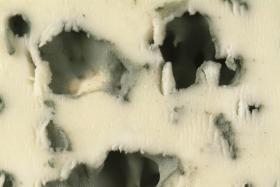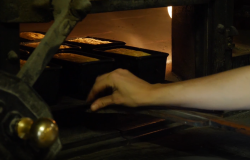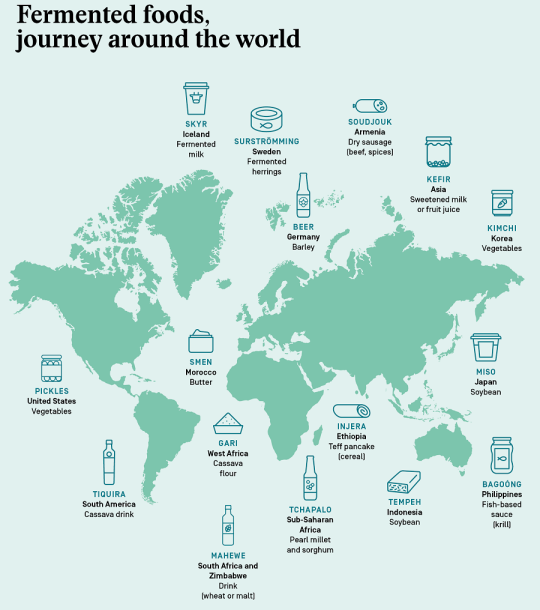Ressources dossier
Food, Global HealthFermented food, sustainable food?
Published on 14 February 2023
Fermenting vegetables means no additives needed for conservation, a natural process without much heavy machinery
Ferment grape juice and you get wine, ferment flour and you get bread, ferment milk and you get yoghurt or cheese… Bread, wine, cheese, yoghurt, but also sauerkraut, gherkins, sausages and olives, among others. Fermented foods are ubiquitous in people’s food and beverages, sometimes unbeknownst to them. Tea, coffee and chocolate are also products of fermentation. This ancestral process, both natural and sustainable, was industrialised in the 1970s and is now gaining ground. Fermentation offers extraordinary potential for eliminating the need for additives, developing novel flavours, and creating new foods. Welcome to the heart of research for the food of tomorrow. Let’s go back to the beginning to take a look at how fermentation came to be.
From empirical knowledge to industrialisation

Throwback to a time that even those over 20 years old can’t remember! A time when refrigerators did not yet exist for food, preservatives were not yet invented, and freezing was a process used only for woolly mammoths. And yet, thousands of years ago, as today, people needed a way to ensure that summer crops could feed them all year round. Fermentation offered solutions. The first traces of fermented foods date back to 13,000 years before Christ in the Mediterranean region, 2,000 BC in the Middle East, and 300 BC in China. As for wine, the oldest jars found in Georgia (Middle East) date to about 6,000 BC.
For many centuries, fermentation was considered to be part of the process of decomposition. It was not until 1857 that Louis Pasteur demonstrated that fermentation is the result of the action of living organisms, namely yeasts and bacteria. He highlighted the biochemical mechanisms of the process, in particular the alcoholic fermentation of wine and beets. It was not until the 1960s/70s that fermentation was developed on an industrial scale, in particular for dairy products such as yoghurt. The aim was to stabilise the process and better control and standardise it, with the ultimate goal of ensuring the safety of these foods by preventing the proliferation of pathogenic bacteria. “The industrialisation of fermentation has made it possible to make the process more reliable and thus to avoid losses caused by possible spontaneous and undesirable fermentation”, explains Sylvie Dequin, head of INRAE’s Microbiology and the Food Chain Division.
Yeast or bacteria?
Both are single-cell organisms, but yeast, a member of the fungi family, has the hallmarks of cells (nucleus, mitochondria, etc.) that bacteria lack.
The art of fermenting
Fermentation results from microorganisms breaking down sugars contained in foods into acid or alcohol.
Fermentation is a simple process. It starts with a matrix –say a fruit, vegetable, meat, grain or legume– to which ferments (yeast or bacteria) are added. The result is a new food with a different taste, texture and nutritional composition. How does it work? In the absence of oxygen, the microorganisms, through the action of their enzymes, break down the sugar (glucose, lactose, maltose, etc.) contained in the food and produce acid or alcohol but also other compounds such as carbon dioxide (CO2), aromas, or vitamins. The production of alcohol, which has antimicrobial properties, or acid, which lowers the pH of the environment and prevents pathogenic bacteria from developing, gives fermented products the advantage of being preserved without having to use preservatives. There are many types of fermentation, such as lactic acid fermentation which allows the production of yoghurt, cheese or sauerkraut, or alcoholic fermentation, carried out by certain yeasts that break down the sugar in grape juice and produce alcohol (ethanol), carbon dioxide and numerous aromatic compounds that endow wine with an array of different tastes. Acetic fermentation transforms wine into vinegar, while propionic fermentation produces cooked cheeses, where the release of carbon dioxide is the cause of the “holes” in Gruyère and Emmental cheese. Malolactic and butyric fermentation, among others, depend on the microorganisms involved, the enzymes produced and the substrates present in the matrix. The combinations are endless.
Good or bad bacteries?
In the wonderful world of microorganisms, there are good guys and bad guys. The bad guys are the pathogenic bacteria, such as Listeria monocytogenes, which causes listeriosis, or salmonella, which causes food poisoning. The good guys are the useful bacteria and yeasts, those that give food its characteristics (flavour, texture, etc.) or simply enable it to last longer. They are also the ones that live in our intestines, and form the intestinal microbiota, whose role in maintaining good health is well-known. As in all good stories, it is (almost) always the good guys who win. It is no different for fermentation: the action of useful bacteria or yeasts generally prevents the development of pathogenic microorganisms, and this in a completely natural way.
Fermented food as a lever for sustainability

Why is fermentation, an ancestral process, making a come-back? “Cheese, cured meat products, bread, wine, beer... fermented foods have always been a big part of western diets. What is new is the fermentation of other fruits and vegetables and the potential for new plant-based dishes that it promises”, explains Catherine Renard, deputy head of INRAE’s Science for Food, Bioproducts and Waste Engineering Division. Indeed, one of the key factors for more sustainable diets in western countries is to bring the plant/animal protein ratio from the current 50/50 to a ratio of 60/40. The challenge is therefore to put more plants on our plates. To appeal to consumers in search of more nature-based foods, fermenting fruit and vegetables to give them new tastes and textures while using a natural process is a very promising avenue. Fermenting plants means dispensing with additives to preserve food. It is a natural process that requires little equipment and keeps waste in check. It can be a useful tool for consumers, to preserve their own production or purchases of fruit and vegetables, but also for market gardeners, as it offers new outlets, particularly for fruit and vegetables that are not the right size or shape to appeal to consumers. Fermentation could also be a way of preserving “short-lived” harvests that are sometimes discarded because they can’t be sold quickly enough.
The challenge is to have more vegetables in our plates!
Lastly, fermentation can also be used for agricultural or agrifood co-products. This is what scientists from INRAE’s Safety and Quality of Processed Fruits and Vegetables (SQPOV) joint research unit in Avignon are studying as part of the European DEMETER project (Use of dietary fibre from pomaces of second-class vegetables as food ingredient). They are working with a vegetable processing factory to study the fermentation of fruit and vegetable by-products in order to enhance their value and avoid waste. For example, the researchers are looking at whether fermenting vegetable peelings, which are rich in microconstituents of interest (vitamins, minerals, antioxidants, etc.), would make it possible to stabilise products that can spoil quickly.
Fermentation is certainly sustainable and offers new texture and taste properties. But what about the health impact of fermented foods?
Baking powder and yeast: not to be confused!
Yeast is a single-cell fungus, of which there are several species, the best known being the Saccharomyces genus responsible for the fermentation of beer or bread. The term “chemical yeast” –a direct translation of levure chimique, or baking powder– is misleading to designate a product that has some of the properties of living yeast (production of CO2), but whose process, which involves only chemical reactions, has nothing to do with fermentation.
Domestication of ferments in a few key dates
Thousands of years ago, humans were already using fermentation to store and conserve summer harvests and also to make alcoholic drinks.
Evolving Ferments
For thousands of years, humans have unwittingly used the power of microorganisms to ferment fruits, vegetables, meat, fish, and grains to produce alcoholic beverages, bread, fermented vegetables, and cured meat products. Over the centuries, these fermentations have led to a natural selection of strains, favouring the most efficient and modifying species such as wine, beer or bread yeasts. These strains have thus acquired new characteristics compared to their wild ancestors and can now be considered domesticated species.
Thanks to comparative genomic approaches developed in recent years, scientists have identified the molecular mechanisms that have contributed to the adaptive evolution of the genomes of these microorganisms. “A remarkable example resulting from the work of the Sciences for Oenology (SPO) unit is that of the Saccharomyces cerevisiae yeasts, used in wine fermentation, which, via a gene transfer from a genetically distant yeast, have acquired the ability to better use the nitrogen resources of the grape must and thus help the fermentation process to run smoothly”, explains Sylvie Dequin. “It is a natural selection of species that has been made to adapt to the processes developed by man”, she continues. These developments contribute to the biodiversity of microorganisms, the vast scope of which is nowadays fully appreciated, particularly in terms of maintaining the diversity of our intestinal microbiota.
As part of the Bakery participatory research project, scientists, with the help of bakers and cereal farmers, have highlighted a great diversity of microorganisms in French bread doughs. While it was thought that only Saccharomyces cerevisiae was in bakers’ yeast, the scientists discovered no less than 12 strains of yeast and 19 species of bacteria! This essential biodiversity is linked to the different varieties of wheat grown and is responsible for the array of nutritional qualities and tastes of bread.

The diversity of baking practices, the biodiversity associated with the bakery sector (terroir, soft wheat varieties, the micro-organisms in leavens) and impacts on the nutritional and sensory quality of bread are all aspects that were studied by the Bakery participatory research project. Picture it here.

Fermented foods are consumed all over the world. They respond to different challenges.
WESTERN COUNTRIES
The aim is to rebalance animal and plant protein intake and develop new fermented plant-based products.
AFRICA
The fermentation of cereals is a major challenge to ensure food security. Processes need to be made safer to reduce losses.
ASIA
Eating fermented plants is part of the culture. Asians have empirical knowledge and they need to develop safer processes.
Participatory research: Citizens of the world, ferment!
Fermenting your own vegetables has become very popular in recent years. Creating new recipes, testing a natural preservation method, doing it yourself, slowing down: these are all arguments for consumers in search of nature-based diets and nutritional quality. How do they do it? Which vegetables do they ferment? Is it safe?
The Flegme citizen science project initiated at the end of 2019 and supported by the Vegepolis Valley competitiveness cluster and INRAE, has monitored the production and consumption practices of 250 citizens who have tried their hand at fermenting their own food. INRAE scientists collected and analysed 75 samples of home-fermented vegetables. The results: more than 30 different vegetables were fermented, including cabbages, carrots, beetroot and lesser-known vegetables such as chayote. “We collected as many recipes as samples! Some made mixtures of vegetables, others added condiments or spices”, explains Florence Valence, head of the CIRM BIA at the Science and Technology of Milk and Eggs (STLO) research unit. And the good news is that none of the samples contained pathogenic bacteria.
A second aspect of the Flegme project is to determine the impact of manufacturing factors such as the amount of salt or the way the vegetables are cut for the fermentation process. “The objective was to carry out controlled manufacturing with an experiment plan on cabbage and carrots to see how these factors have an impact on the bacterial ecosystems and their kinetics.” This research, carried out in collaboration with two companies (CTCPA and Protial), shows that at the beginning of lacto-fermentation (fermentation of vegetables with salt), enterobacteria, which are pathogenic, develop, but are quickly countered by lactic acid bacteria, thus confirming their protective and preservative effect. At the end of the process, the ecosystem is dominated by lactic acid bacteria, as pathogenic bacteria are no longer found alive in the samples. This study also showed that the degree of cutting had an impact on the fermentation. In the case of cabbage, fermentation is better controlled if the vegetable is sliced compared to leafy cabbage. It was also found that the usual salt concentration of 1% could be reduced to 0.8% without any noticeable impact on fermentation.
Finally, the project leaders also worked with sociologists to understand the obstacles to and motivations for consuming lacto-fermented vegetables. The “home-made” advantage combined with the health image often associated with lacto-fermented vegetables were among the primary motivating factors for consuming them. Work has also been carried out with vocational high schools and restaurant owners to develop recipes based on fermented vegetables. “This process is not new, but there is still work to be done to make consumers aware of and appreciate these vegetables. There is a real lack of knowledge among the public about what fermented food is and the fact that they are ingesting living microorganisms”, concludes Florence Valence.
-
Elodie Regnier
(Send email)
Author / Translated by Inge Laino
-
Arthur Bonifay
Illustrator
